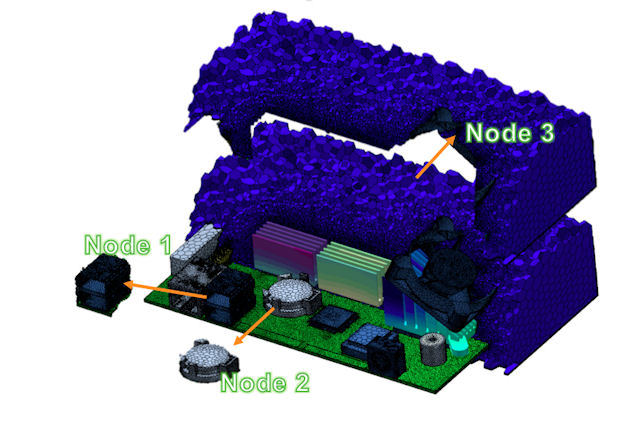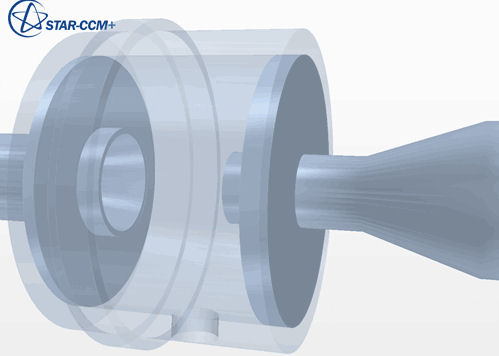Latest News
July 2, 2014
CD-adapco has announced version 9.04 of its STAR-CCM+ integrated engineering simulation solution. The company says that v9.04, the second 2014 release of its flagship computational fluid dynamics-based simulation software, offers users faster overall time to solution as well as productivity gains via workflow improvements, parallel meshing functions and optimization capabilities.
 The new concurrent per-part meshing (CPPM) capability in STAR-CCM+ v9.04 allows users to mesh individual parts in serial, with each part being meshed distributed to an individual processor. The company reports that in previous versions of STAR-CCM+ this example took more than seven hours to complete. With concurrent per-part meshing, this process can now take as little as one and a half hours to complete. Image courtesy of CD-adapco.
The new concurrent per-part meshing (CPPM) capability in STAR-CCM+ v9.04 allows users to mesh individual parts in serial, with each part being meshed distributed to an individual processor. The company reports that in previous versions of STAR-CCM+ this example took more than seven hours to complete. With concurrent per-part meshing, this process can now take as little as one and a half hours to complete. Image courtesy of CD-adapco.Among the new features of version 9.04 highlighted by the company are concurrent per-part meshing (CPPM), the ability to perform CAD robustness studies and an expression cost function for adjoint solver. Additionally, the software’s dynamic fluid body interaction (DFBI) solver now offers new Contact Coupling feature, and v9.04 also introduces a number of interface enhancements.
Concurrent per-part meshing allows you to mesh large and complex assemblies by assigning each part to a separate parallel processor. This capability says the company, lets you leverage as much computing power as you have available to wrap, mesh or remesh your geometry.
STAR-CCM+ v9.04, as well as the company’s Optimate line of design exploration and optimization tools, now provide you the option to run a CAD robustness study before you perform a full analysis. This allows you to check a design’s robustness quickly and ensures that computational time will be spent performing simulations on viable geometric configurations rather than repairing CAD regeneration failures. The company says that not only do CAD robustness studies save you time, they also give you confidence that you will find better designs faster.
 In STAR CCM+ V9.04, the DFBI (Dynamic Fluid Body Interaction) solver has been enhanced with a new Contact Coupling feature for modeling contact and collisions between moving bodies and boundaries. Image courtesy of CD-adapco.
In STAR CCM+ V9.04, the DFBI (Dynamic Fluid Body Interaction) solver has been enhanced with a new Contact Coupling feature for modeling contact and collisions between moving bodies and boundaries. Image courtesy of CD-adapco.The STAR-CCM+ adjoint solver gives you information about how modifying a design’s shape, flow field and boundary conditions will affect your cost functions, which represent your engineering objectives. The new expression cost function available for the adjoint solver introduced in STAR-CCM+ v9.04 allows you to mathematically combine cost functions into arbitrary formulas. Both individual and combined sensitivities can then be used to more precisely guide the improvement of your design, according to CD-adapco.
The DFBI solver’s new Contact Coupling feature lets you model contact and collision between moving bodies and boundaries. To take into account additional (non-fluid) forces acting on DFBI bodies, you can use the Contact Coupling model with other DFBI models, such as the catenary coupling and the linear spring models.
Among the workflow and interface enhancements introduced in STAR-CCM+ v9.04 are Field Function editing, improvements to the Filtering feature and an interactive color map editor, according to CD-adapco. Syntax highlighting and parenthesis matching in the Field Editor, says the company, now provide you with immediate feedback on whether you constructed an expression correctly.
 Version 9.04 of STAR-CCM+ introduces an option for performing a CAD robustness study before you perform your full analysis. Image courtesy of CD-adapco.
Version 9.04 of STAR-CCM+ introduces an option for performing a CAD robustness study before you perform your full analysis. Image courtesy of CD-adapco.The Filtering feature is now capable of supporting queries and conditional expressions to group entities, reports the company. You can also use groups for setting up physics and analyzing solutions.
STAR-CCM+ v9.04 marks the debut of a new interactive color map editor for creating visualizations. This feature lets you create, modify, copy/paste and import/export your own color maps. You can preview changes interactively, and use the feature in combination with volume rendering.
“With STAR-CCM+ v9.04 we have continued to add new modeling capabilities, increasing accuracy realism and throughput of their applications results,” said Senior VP of Product Management, Jean-Claude Ercolanelli in a press statement. “The development of the STAR-CCM+ v9 [series of] releases remains completely focused on simulating large and complex models more easily, faster and in the shortest amount of time.”
For further details on STAR-CCM+ v9.04, go to CD-adapco.
Click here to learn more about concurrent per-part meshing in STAR-CCM+ v9.04.
Learn more about CAD robustness and adjoint expressions.
More details on the DFBI Contact Coupling model are here.
STAR-CCM+ v9.04’s interface enhancements are discussed here.
See why DE‘s Editors selected STAR-CCM+ v9.04 as their Pick of the Week.
Sources: Press materials received from the company and additional information gleaned from the company’s website.
Subscribe to our FREE magazine, FREE email newsletters or both!
Latest News
About the Author
Anthony J. Lockwood is Digital Engineering’s founding editor. He is now retired. Contact him via [email protected].
Follow DERelated Topics






